Cross-Cultural Communication: Business, Ethics, and Misunderstandings
VerifiedAdded on 2020/05/16
|10
|2553
|86
Essay
AI Summary
This essay delves into the critical aspects of cross-cultural communication within a business context. It begins by highlighting why cross-cultural communication (CCC) is a significant business and ethical issue, emphasizing how cultural differences can impede effective communication and create ethical dilemmas. The essay explores the importance of understanding cultural nuances, ethical considerations, and the need for internal communication strategies to navigate global market challenges. It emphasizes the value of individual differences over cultural adaptation, and explains how successful cross-cultural communication provides a competitive advantage. The essay then compares and contrasts communication styles between Nepal and Australia, identifying potential misunderstandings arising from these differences, and the negative impacts on business. It concludes by discussing how overemphasizing cultural differences can lead to stereotypes, hindering effective communication, and the importance of diminishing differences to foster unity.
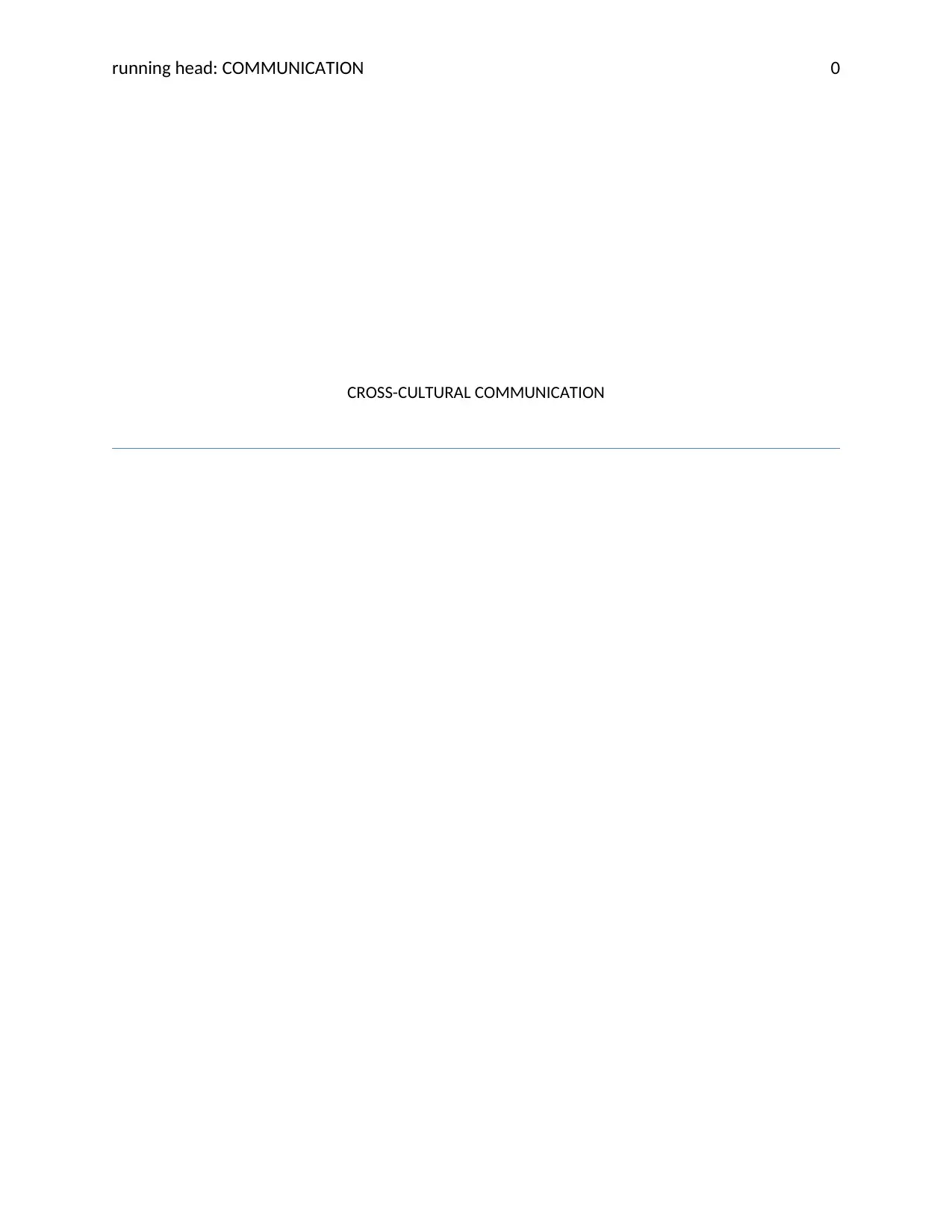
running head: COMMUNICATION 0
CROSS-CULTURAL COMMUNICATION
CROSS-CULTURAL COMMUNICATION
Paraphrase This Document
Need a fresh take? Get an instant paraphrase of this document with our AI Paraphraser

COMMUNICATION 1
Table of Contents
QUESTIONS:................................................................................................................................... 1
References:.................................................................................................................................... 7
Table of Contents
QUESTIONS:................................................................................................................................... 1
References:.................................................................................................................................... 7
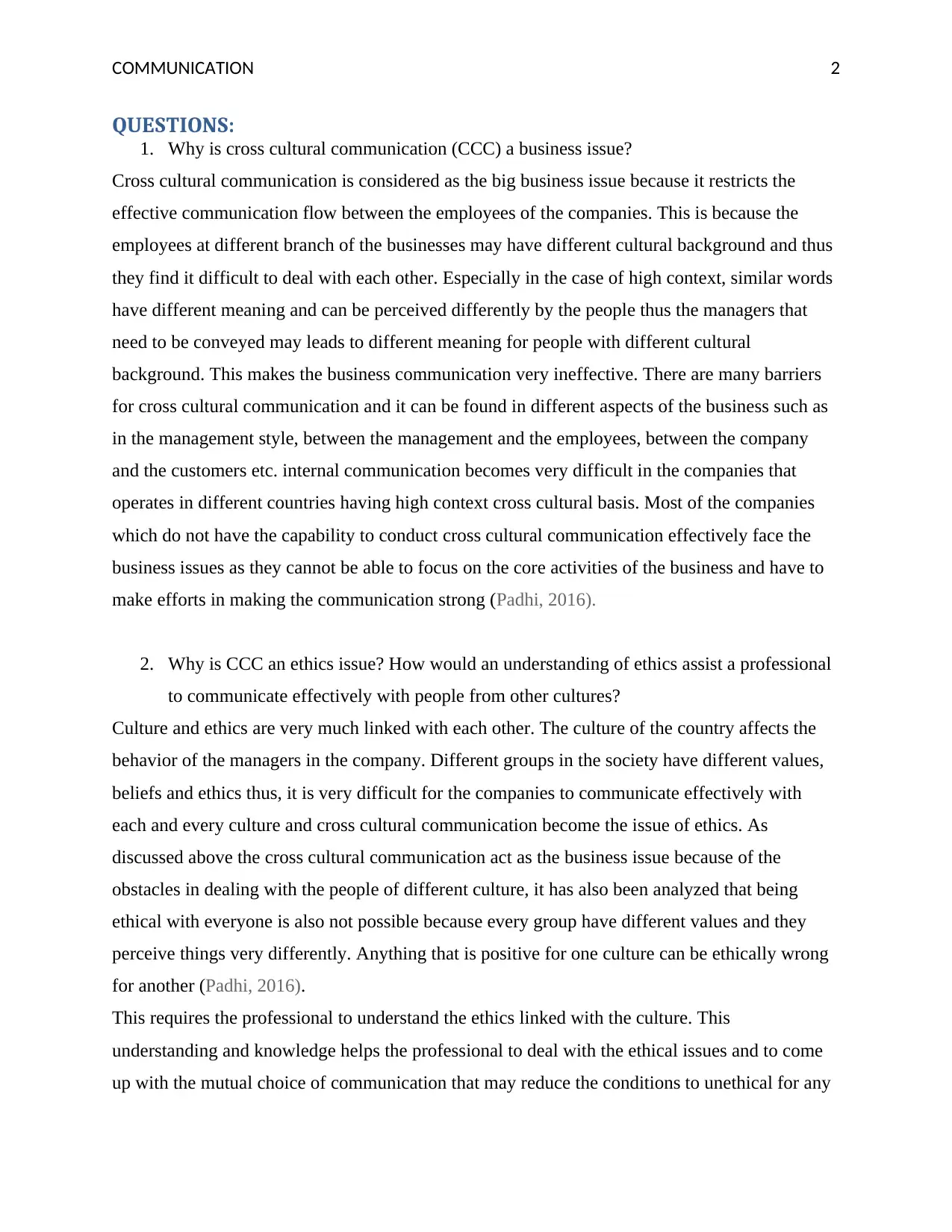
COMMUNICATION 2
QUESTIONS:
1. Why is cross cultural communication (CCC) a business issue?
Cross cultural communication is considered as the big business issue because it restricts the
effective communication flow between the employees of the companies. This is because the
employees at different branch of the businesses may have different cultural background and thus
they find it difficult to deal with each other. Especially in the case of high context, similar words
have different meaning and can be perceived differently by the people thus the managers that
need to be conveyed may leads to different meaning for people with different cultural
background. This makes the business communication very ineffective. There are many barriers
for cross cultural communication and it can be found in different aspects of the business such as
in the management style, between the management and the employees, between the company
and the customers etc. internal communication becomes very difficult in the companies that
operates in different countries having high context cross cultural basis. Most of the companies
which do not have the capability to conduct cross cultural communication effectively face the
business issues as they cannot be able to focus on the core activities of the business and have to
make efforts in making the communication strong (Padhi, 2016).
2. Why is CCC an ethics issue? How would an understanding of ethics assist a professional
to communicate effectively with people from other cultures?
Culture and ethics are very much linked with each other. The culture of the country affects the
behavior of the managers in the company. Different groups in the society have different values,
beliefs and ethics thus, it is very difficult for the companies to communicate effectively with
each and every culture and cross cultural communication become the issue of ethics. As
discussed above the cross cultural communication act as the business issue because of the
obstacles in dealing with the people of different culture, it has also been analyzed that being
ethical with everyone is also not possible because every group have different values and they
perceive things very differently. Anything that is positive for one culture can be ethically wrong
for another (Padhi, 2016).
This requires the professional to understand the ethics linked with the culture. This
understanding and knowledge helps the professional to deal with the ethical issues and to come
up with the mutual choice of communication that may reduce the conditions to unethical for any
QUESTIONS:
1. Why is cross cultural communication (CCC) a business issue?
Cross cultural communication is considered as the big business issue because it restricts the
effective communication flow between the employees of the companies. This is because the
employees at different branch of the businesses may have different cultural background and thus
they find it difficult to deal with each other. Especially in the case of high context, similar words
have different meaning and can be perceived differently by the people thus the managers that
need to be conveyed may leads to different meaning for people with different cultural
background. This makes the business communication very ineffective. There are many barriers
for cross cultural communication and it can be found in different aspects of the business such as
in the management style, between the management and the employees, between the company
and the customers etc. internal communication becomes very difficult in the companies that
operates in different countries having high context cross cultural basis. Most of the companies
which do not have the capability to conduct cross cultural communication effectively face the
business issues as they cannot be able to focus on the core activities of the business and have to
make efforts in making the communication strong (Padhi, 2016).
2. Why is CCC an ethics issue? How would an understanding of ethics assist a professional
to communicate effectively with people from other cultures?
Culture and ethics are very much linked with each other. The culture of the country affects the
behavior of the managers in the company. Different groups in the society have different values,
beliefs and ethics thus, it is very difficult for the companies to communicate effectively with
each and every culture and cross cultural communication become the issue of ethics. As
discussed above the cross cultural communication act as the business issue because of the
obstacles in dealing with the people of different culture, it has also been analyzed that being
ethical with everyone is also not possible because every group have different values and they
perceive things very differently. Anything that is positive for one culture can be ethically wrong
for another (Padhi, 2016).
This requires the professional to understand the ethics linked with the culture. This
understanding and knowledge helps the professional to deal with the ethical issues and to come
up with the mutual choice of communication that may reduce the conditions to unethical for any
⊘ This is a preview!⊘
Do you want full access?
Subscribe today to unlock all pages.

Trusted by 1+ million students worldwide
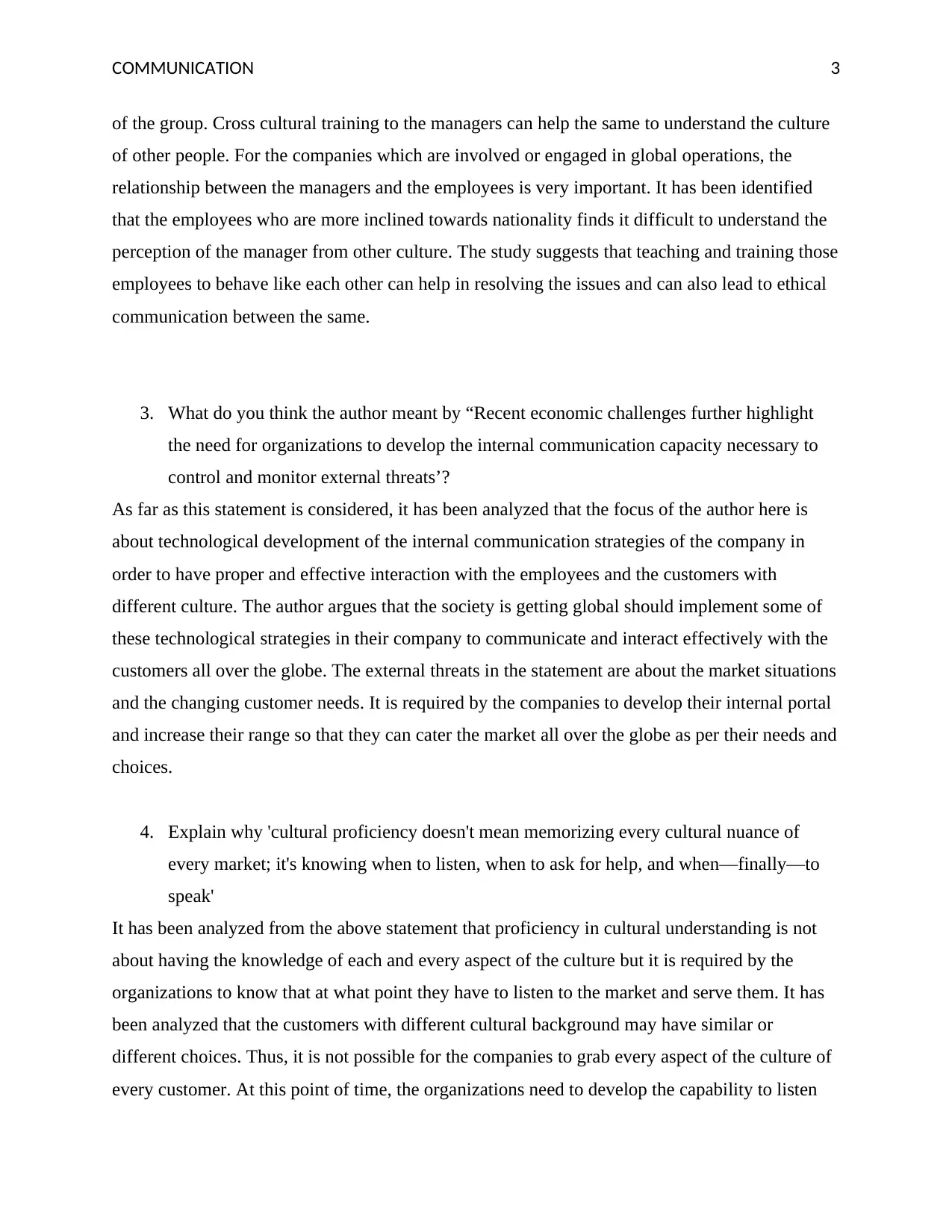
COMMUNICATION 3
of the group. Cross cultural training to the managers can help the same to understand the culture
of other people. For the companies which are involved or engaged in global operations, the
relationship between the managers and the employees is very important. It has been identified
that the employees who are more inclined towards nationality finds it difficult to understand the
perception of the manager from other culture. The study suggests that teaching and training those
employees to behave like each other can help in resolving the issues and can also lead to ethical
communication between the same.
3. What do you think the author meant by “Recent economic challenges further highlight
the need for organizations to develop the internal communication capacity necessary to
control and monitor external threats’?
As far as this statement is considered, it has been analyzed that the focus of the author here is
about technological development of the internal communication strategies of the company in
order to have proper and effective interaction with the employees and the customers with
different culture. The author argues that the society is getting global should implement some of
these technological strategies in their company to communicate and interact effectively with the
customers all over the globe. The external threats in the statement are about the market situations
and the changing customer needs. It is required by the companies to develop their internal portal
and increase their range so that they can cater the market all over the globe as per their needs and
choices.
4. Explain why 'cultural proficiency doesn't mean memorizing every cultural nuance of
every market; it's knowing when to listen, when to ask for help, and when—finally—to
speak'
It has been analyzed from the above statement that proficiency in cultural understanding is not
about having the knowledge of each and every aspect of the culture but it is required by the
organizations to know that at what point they have to listen to the market and serve them. It has
been analyzed that the customers with different cultural background may have similar or
different choices. Thus, it is not possible for the companies to grab every aspect of the culture of
every customer. At this point of time, the organizations need to develop the capability to listen
of the group. Cross cultural training to the managers can help the same to understand the culture
of other people. For the companies which are involved or engaged in global operations, the
relationship between the managers and the employees is very important. It has been identified
that the employees who are more inclined towards nationality finds it difficult to understand the
perception of the manager from other culture. The study suggests that teaching and training those
employees to behave like each other can help in resolving the issues and can also lead to ethical
communication between the same.
3. What do you think the author meant by “Recent economic challenges further highlight
the need for organizations to develop the internal communication capacity necessary to
control and monitor external threats’?
As far as this statement is considered, it has been analyzed that the focus of the author here is
about technological development of the internal communication strategies of the company in
order to have proper and effective interaction with the employees and the customers with
different culture. The author argues that the society is getting global should implement some of
these technological strategies in their company to communicate and interact effectively with the
customers all over the globe. The external threats in the statement are about the market situations
and the changing customer needs. It is required by the companies to develop their internal portal
and increase their range so that they can cater the market all over the globe as per their needs and
choices.
4. Explain why 'cultural proficiency doesn't mean memorizing every cultural nuance of
every market; it's knowing when to listen, when to ask for help, and when—finally—to
speak'
It has been analyzed from the above statement that proficiency in cultural understanding is not
about having the knowledge of each and every aspect of the culture but it is required by the
organizations to know that at what point they have to listen to the market and serve them. It has
been analyzed that the customers with different cultural background may have similar or
different choices. Thus, it is not possible for the companies to grab every aspect of the culture of
every customer. At this point of time, the organizations need to develop the capability to listen
Paraphrase This Document
Need a fresh take? Get an instant paraphrase of this document with our AI Paraphraser
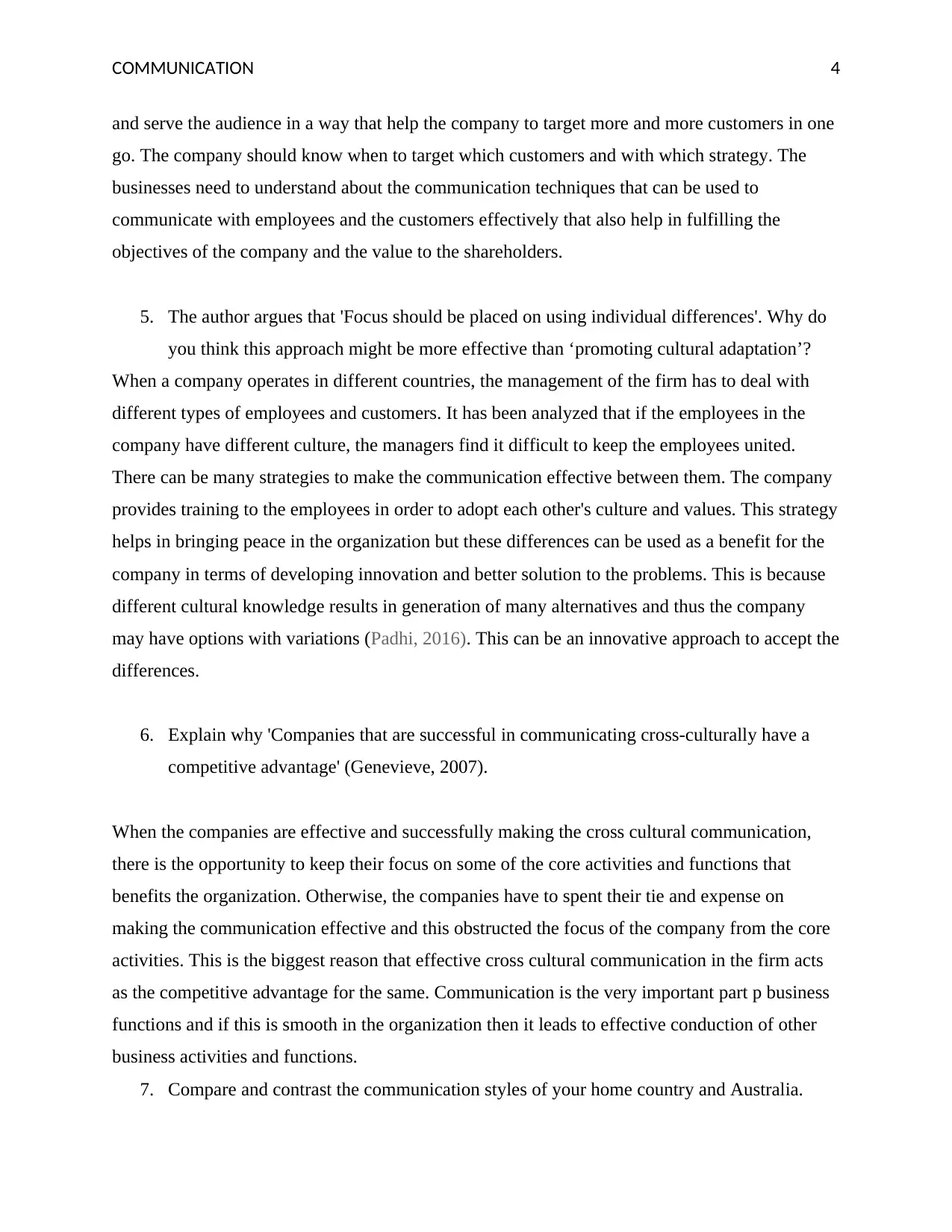
COMMUNICATION 4
and serve the audience in a way that help the company to target more and more customers in one
go. The company should know when to target which customers and with which strategy. The
businesses need to understand about the communication techniques that can be used to
communicate with employees and the customers effectively that also help in fulfilling the
objectives of the company and the value to the shareholders.
5. The author argues that 'Focus should be placed on using individual differences'. Why do
you think this approach might be more effective than ‘promoting cultural adaptation’?
When a company operates in different countries, the management of the firm has to deal with
different types of employees and customers. It has been analyzed that if the employees in the
company have different culture, the managers find it difficult to keep the employees united.
There can be many strategies to make the communication effective between them. The company
provides training to the employees in order to adopt each other's culture and values. This strategy
helps in bringing peace in the organization but these differences can be used as a benefit for the
company in terms of developing innovation and better solution to the problems. This is because
different cultural knowledge results in generation of many alternatives and thus the company
may have options with variations (Padhi, 2016). This can be an innovative approach to accept the
differences.
6. Explain why 'Companies that are successful in communicating cross-culturally have a
competitive advantage' (Genevieve, 2007).
When the companies are effective and successfully making the cross cultural communication,
there is the opportunity to keep their focus on some of the core activities and functions that
benefits the organization. Otherwise, the companies have to spent their tie and expense on
making the communication effective and this obstructed the focus of the company from the core
activities. This is the biggest reason that effective cross cultural communication in the firm acts
as the competitive advantage for the same. Communication is the very important part p business
functions and if this is smooth in the organization then it leads to effective conduction of other
business activities and functions.
7. Compare and contrast the communication styles of your home country and Australia.
and serve the audience in a way that help the company to target more and more customers in one
go. The company should know when to target which customers and with which strategy. The
businesses need to understand about the communication techniques that can be used to
communicate with employees and the customers effectively that also help in fulfilling the
objectives of the company and the value to the shareholders.
5. The author argues that 'Focus should be placed on using individual differences'. Why do
you think this approach might be more effective than ‘promoting cultural adaptation’?
When a company operates in different countries, the management of the firm has to deal with
different types of employees and customers. It has been analyzed that if the employees in the
company have different culture, the managers find it difficult to keep the employees united.
There can be many strategies to make the communication effective between them. The company
provides training to the employees in order to adopt each other's culture and values. This strategy
helps in bringing peace in the organization but these differences can be used as a benefit for the
company in terms of developing innovation and better solution to the problems. This is because
different cultural knowledge results in generation of many alternatives and thus the company
may have options with variations (Padhi, 2016). This can be an innovative approach to accept the
differences.
6. Explain why 'Companies that are successful in communicating cross-culturally have a
competitive advantage' (Genevieve, 2007).
When the companies are effective and successfully making the cross cultural communication,
there is the opportunity to keep their focus on some of the core activities and functions that
benefits the organization. Otherwise, the companies have to spent their tie and expense on
making the communication effective and this obstructed the focus of the company from the core
activities. This is the biggest reason that effective cross cultural communication in the firm acts
as the competitive advantage for the same. Communication is the very important part p business
functions and if this is smooth in the organization then it leads to effective conduction of other
business activities and functions.
7. Compare and contrast the communication styles of your home country and Australia.
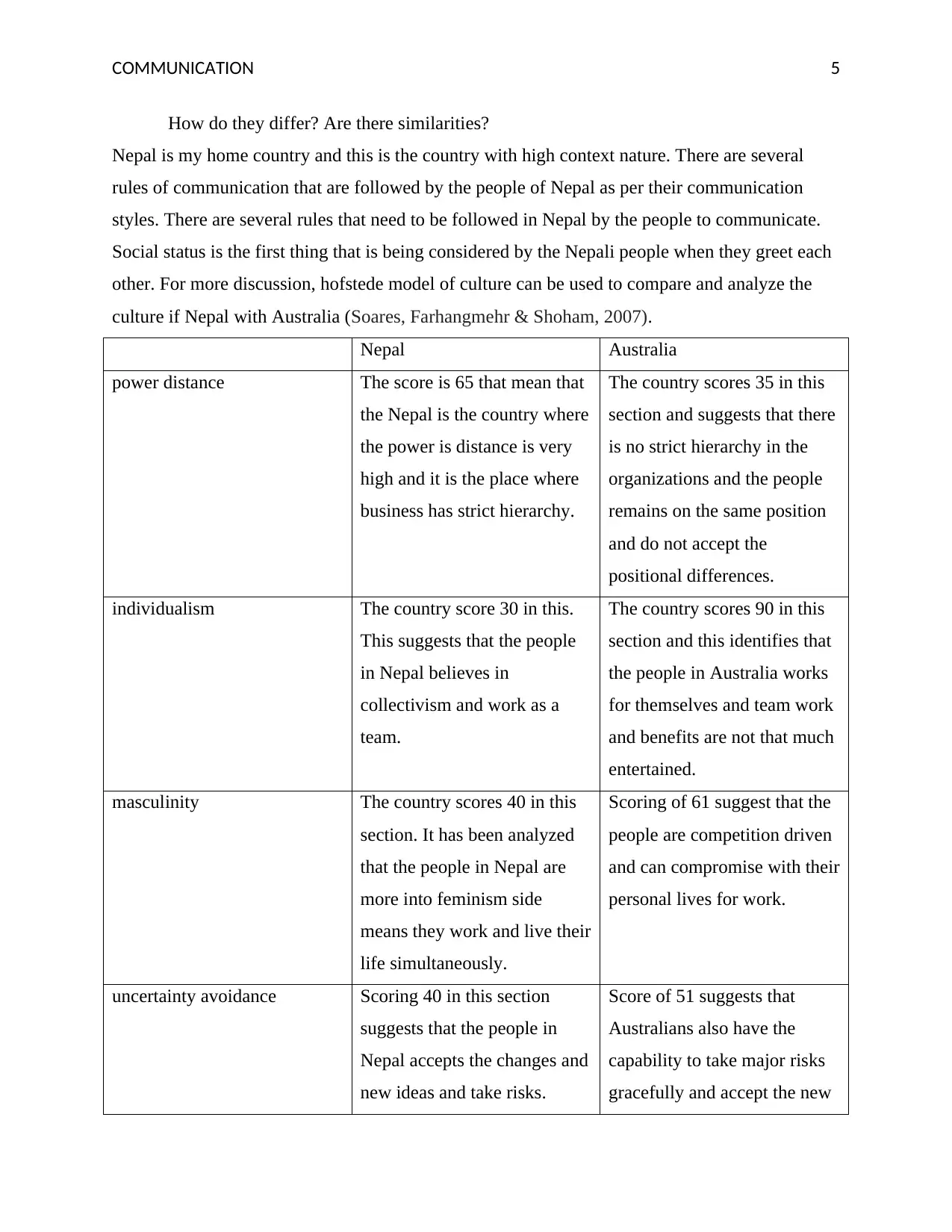
COMMUNICATION 5
How do they differ? Are there similarities?
Nepal is my home country and this is the country with high context nature. There are several
rules of communication that are followed by the people of Nepal as per their communication
styles. There are several rules that need to be followed in Nepal by the people to communicate.
Social status is the first thing that is being considered by the Nepali people when they greet each
other. For more discussion, hofstede model of culture can be used to compare and analyze the
culture if Nepal with Australia (Soares, Farhangmehr & Shoham, 2007).
Nepal Australia
power distance The score is 65 that mean that
the Nepal is the country where
the power is distance is very
high and it is the place where
business has strict hierarchy.
The country scores 35 in this
section and suggests that there
is no strict hierarchy in the
organizations and the people
remains on the same position
and do not accept the
positional differences.
individualism The country score 30 in this.
This suggests that the people
in Nepal believes in
collectivism and work as a
team.
The country scores 90 in this
section and this identifies that
the people in Australia works
for themselves and team work
and benefits are not that much
entertained.
masculinity The country scores 40 in this
section. It has been analyzed
that the people in Nepal are
more into feminism side
means they work and live their
life simultaneously.
Scoring of 61 suggest that the
people are competition driven
and can compromise with their
personal lives for work.
uncertainty avoidance Scoring 40 in this section
suggests that the people in
Nepal accepts the changes and
new ideas and take risks.
Score of 51 suggests that
Australians also have the
capability to take major risks
gracefully and accept the new
How do they differ? Are there similarities?
Nepal is my home country and this is the country with high context nature. There are several
rules of communication that are followed by the people of Nepal as per their communication
styles. There are several rules that need to be followed in Nepal by the people to communicate.
Social status is the first thing that is being considered by the Nepali people when they greet each
other. For more discussion, hofstede model of culture can be used to compare and analyze the
culture if Nepal with Australia (Soares, Farhangmehr & Shoham, 2007).
Nepal Australia
power distance The score is 65 that mean that
the Nepal is the country where
the power is distance is very
high and it is the place where
business has strict hierarchy.
The country scores 35 in this
section and suggests that there
is no strict hierarchy in the
organizations and the people
remains on the same position
and do not accept the
positional differences.
individualism The country score 30 in this.
This suggests that the people
in Nepal believes in
collectivism and work as a
team.
The country scores 90 in this
section and this identifies that
the people in Australia works
for themselves and team work
and benefits are not that much
entertained.
masculinity The country scores 40 in this
section. It has been analyzed
that the people in Nepal are
more into feminism side
means they work and live their
life simultaneously.
Scoring of 61 suggest that the
people are competition driven
and can compromise with their
personal lives for work.
uncertainty avoidance Scoring 40 in this section
suggests that the people in
Nepal accepts the changes and
new ideas and take risks.
Score of 51 suggests that
Australians also have the
capability to take major risks
gracefully and accept the new
⊘ This is a preview!⊘
Do you want full access?
Subscribe today to unlock all pages.

Trusted by 1+ million students worldwide
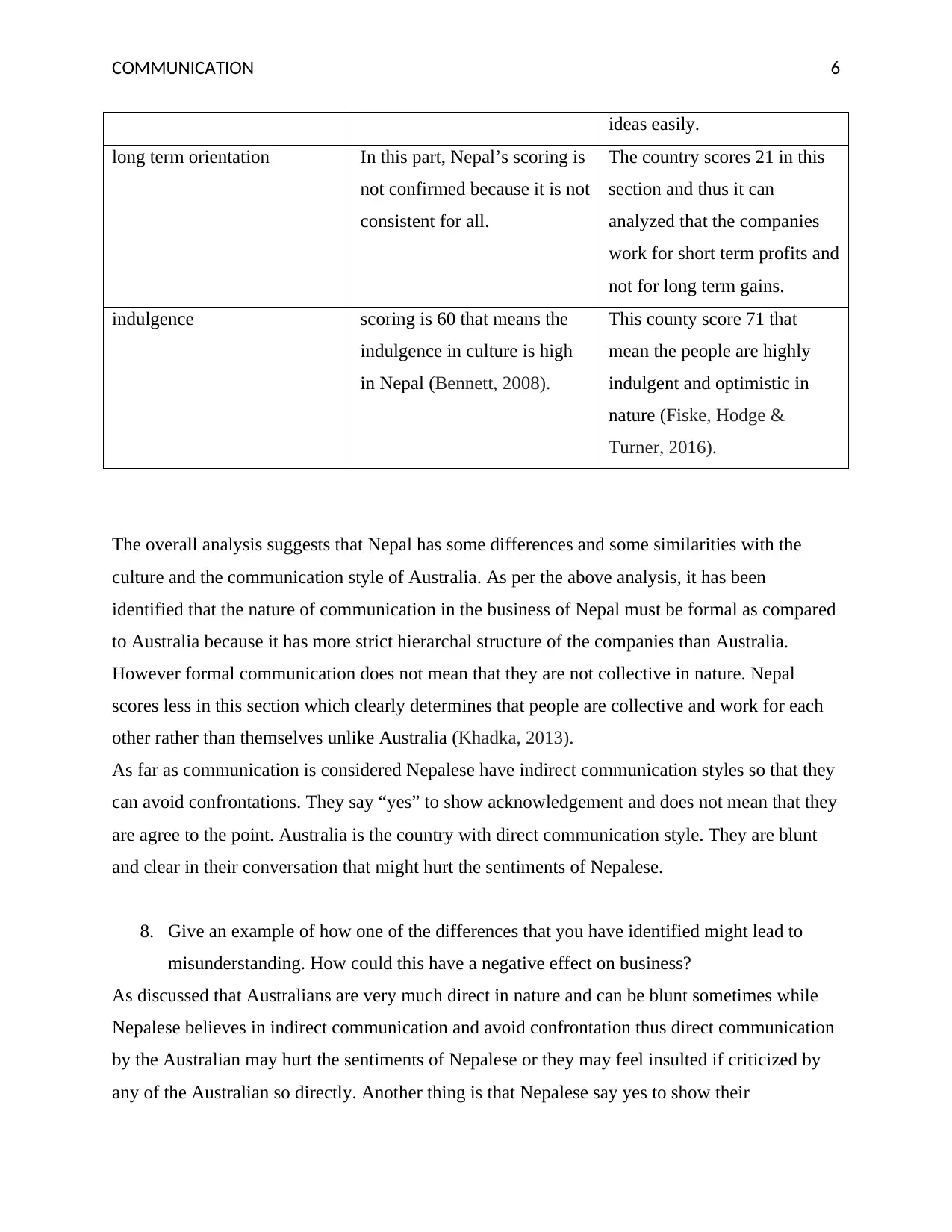
COMMUNICATION 6
ideas easily.
long term orientation In this part, Nepal’s scoring is
not confirmed because it is not
consistent for all.
The country scores 21 in this
section and thus it can
analyzed that the companies
work for short term profits and
not for long term gains.
indulgence scoring is 60 that means the
indulgence in culture is high
in Nepal (Bennett, 2008).
This county score 71 that
mean the people are highly
indulgent and optimistic in
nature (Fiske, Hodge &
Turner, 2016).
The overall analysis suggests that Nepal has some differences and some similarities with the
culture and the communication style of Australia. As per the above analysis, it has been
identified that the nature of communication in the business of Nepal must be formal as compared
to Australia because it has more strict hierarchal structure of the companies than Australia.
However formal communication does not mean that they are not collective in nature. Nepal
scores less in this section which clearly determines that people are collective and work for each
other rather than themselves unlike Australia (Khadka, 2013).
As far as communication is considered Nepalese have indirect communication styles so that they
can avoid confrontations. They say “yes” to show acknowledgement and does not mean that they
are agree to the point. Australia is the country with direct communication style. They are blunt
and clear in their conversation that might hurt the sentiments of Nepalese.
8. Give an example of how one of the differences that you have identified might lead to
misunderstanding. How could this have a negative effect on business?
As discussed that Australians are very much direct in nature and can be blunt sometimes while
Nepalese believes in indirect communication and avoid confrontation thus direct communication
by the Australian may hurt the sentiments of Nepalese or they may feel insulted if criticized by
any of the Australian so directly. Another thing is that Nepalese say yes to show their
ideas easily.
long term orientation In this part, Nepal’s scoring is
not confirmed because it is not
consistent for all.
The country scores 21 in this
section and thus it can
analyzed that the companies
work for short term profits and
not for long term gains.
indulgence scoring is 60 that means the
indulgence in culture is high
in Nepal (Bennett, 2008).
This county score 71 that
mean the people are highly
indulgent and optimistic in
nature (Fiske, Hodge &
Turner, 2016).
The overall analysis suggests that Nepal has some differences and some similarities with the
culture and the communication style of Australia. As per the above analysis, it has been
identified that the nature of communication in the business of Nepal must be formal as compared
to Australia because it has more strict hierarchal structure of the companies than Australia.
However formal communication does not mean that they are not collective in nature. Nepal
scores less in this section which clearly determines that people are collective and work for each
other rather than themselves unlike Australia (Khadka, 2013).
As far as communication is considered Nepalese have indirect communication styles so that they
can avoid confrontations. They say “yes” to show acknowledgement and does not mean that they
are agree to the point. Australia is the country with direct communication style. They are blunt
and clear in their conversation that might hurt the sentiments of Nepalese.
8. Give an example of how one of the differences that you have identified might lead to
misunderstanding. How could this have a negative effect on business?
As discussed that Australians are very much direct in nature and can be blunt sometimes while
Nepalese believes in indirect communication and avoid confrontation thus direct communication
by the Australian may hurt the sentiments of Nepalese or they may feel insulted if criticized by
any of the Australian so directly. Another thing is that Nepalese say yes to show their
Paraphrase This Document
Need a fresh take? Get an instant paraphrase of this document with our AI Paraphraser
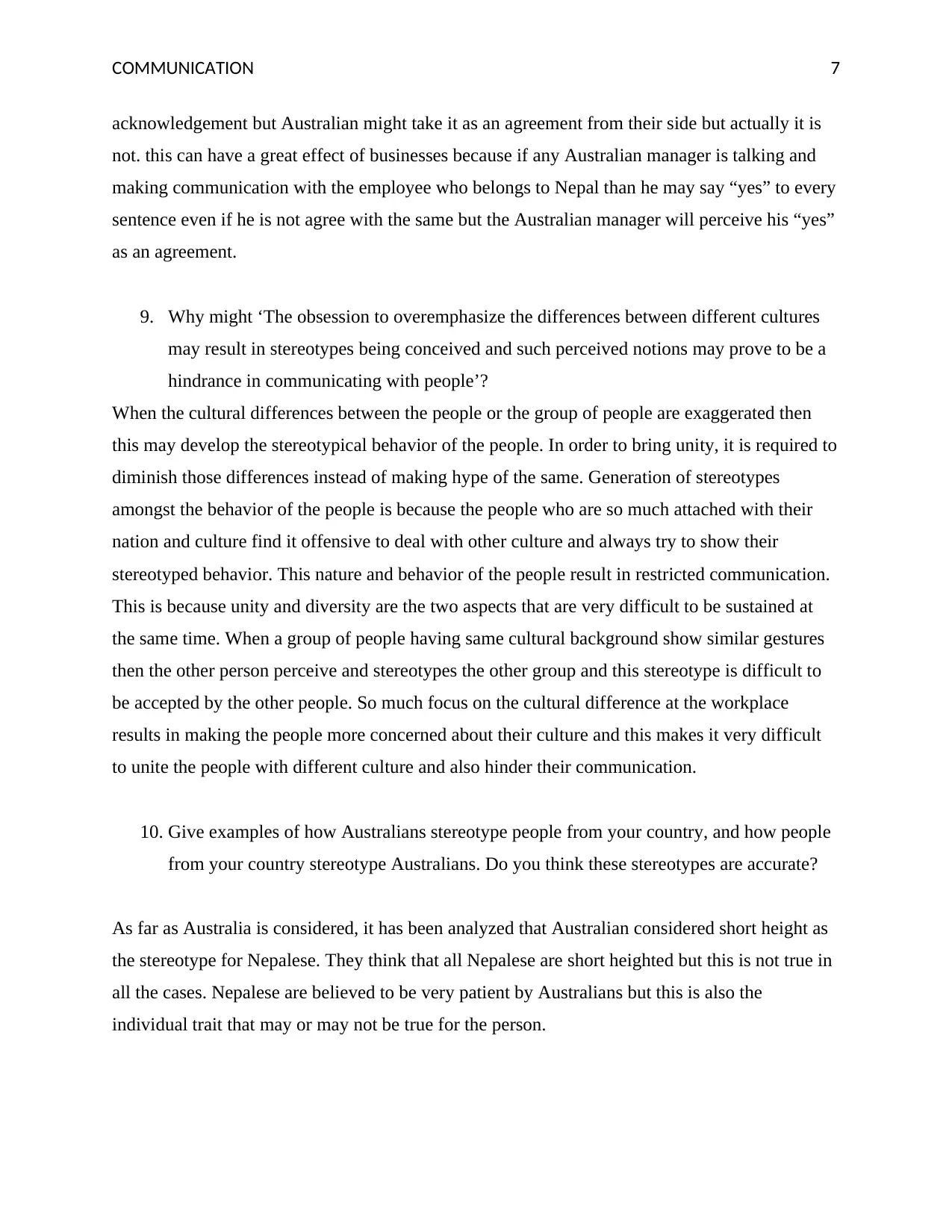
COMMUNICATION 7
acknowledgement but Australian might take it as an agreement from their side but actually it is
not. this can have a great effect of businesses because if any Australian manager is talking and
making communication with the employee who belongs to Nepal than he may say “yes” to every
sentence even if he is not agree with the same but the Australian manager will perceive his “yes”
as an agreement.
9. Why might ‘The obsession to overemphasize the differences between different cultures
may result in stereotypes being conceived and such perceived notions may prove to be a
hindrance in communicating with people’?
When the cultural differences between the people or the group of people are exaggerated then
this may develop the stereotypical behavior of the people. In order to bring unity, it is required to
diminish those differences instead of making hype of the same. Generation of stereotypes
amongst the behavior of the people is because the people who are so much attached with their
nation and culture find it offensive to deal with other culture and always try to show their
stereotyped behavior. This nature and behavior of the people result in restricted communication.
This is because unity and diversity are the two aspects that are very difficult to be sustained at
the same time. When a group of people having same cultural background show similar gestures
then the other person perceive and stereotypes the other group and this stereotype is difficult to
be accepted by the other people. So much focus on the cultural difference at the workplace
results in making the people more concerned about their culture and this makes it very difficult
to unite the people with different culture and also hinder their communication.
10. Give examples of how Australians stereotype people from your country, and how people
from your country stereotype Australians. Do you think these stereotypes are accurate?
As far as Australia is considered, it has been analyzed that Australian considered short height as
the stereotype for Nepalese. They think that all Nepalese are short heighted but this is not true in
all the cases. Nepalese are believed to be very patient by Australians but this is also the
individual trait that may or may not be true for the person.
acknowledgement but Australian might take it as an agreement from their side but actually it is
not. this can have a great effect of businesses because if any Australian manager is talking and
making communication with the employee who belongs to Nepal than he may say “yes” to every
sentence even if he is not agree with the same but the Australian manager will perceive his “yes”
as an agreement.
9. Why might ‘The obsession to overemphasize the differences between different cultures
may result in stereotypes being conceived and such perceived notions may prove to be a
hindrance in communicating with people’?
When the cultural differences between the people or the group of people are exaggerated then
this may develop the stereotypical behavior of the people. In order to bring unity, it is required to
diminish those differences instead of making hype of the same. Generation of stereotypes
amongst the behavior of the people is because the people who are so much attached with their
nation and culture find it offensive to deal with other culture and always try to show their
stereotyped behavior. This nature and behavior of the people result in restricted communication.
This is because unity and diversity are the two aspects that are very difficult to be sustained at
the same time. When a group of people having same cultural background show similar gestures
then the other person perceive and stereotypes the other group and this stereotype is difficult to
be accepted by the other people. So much focus on the cultural difference at the workplace
results in making the people more concerned about their culture and this makes it very difficult
to unite the people with different culture and also hinder their communication.
10. Give examples of how Australians stereotype people from your country, and how people
from your country stereotype Australians. Do you think these stereotypes are accurate?
As far as Australia is considered, it has been analyzed that Australian considered short height as
the stereotype for Nepalese. They think that all Nepalese are short heighted but this is not true in
all the cases. Nepalese are believed to be very patient by Australians but this is also the
individual trait that may or may not be true for the person.

COMMUNICATION 8
As far as Nepalese are considered, they think that al Australians have good sense of humor
which is accurate to an extent. The conversation with the Australia is always full with slangs and
they may differ with age. This is a stereotype thing of Nepalese for Australians.
As far as Nepalese are considered, they think that al Australians have good sense of humor
which is accurate to an extent. The conversation with the Australia is always full with slangs and
they may differ with age. This is a stereotype thing of Nepalese for Australians.
⊘ This is a preview!⊘
Do you want full access?
Subscribe today to unlock all pages.

Trusted by 1+ million students worldwide
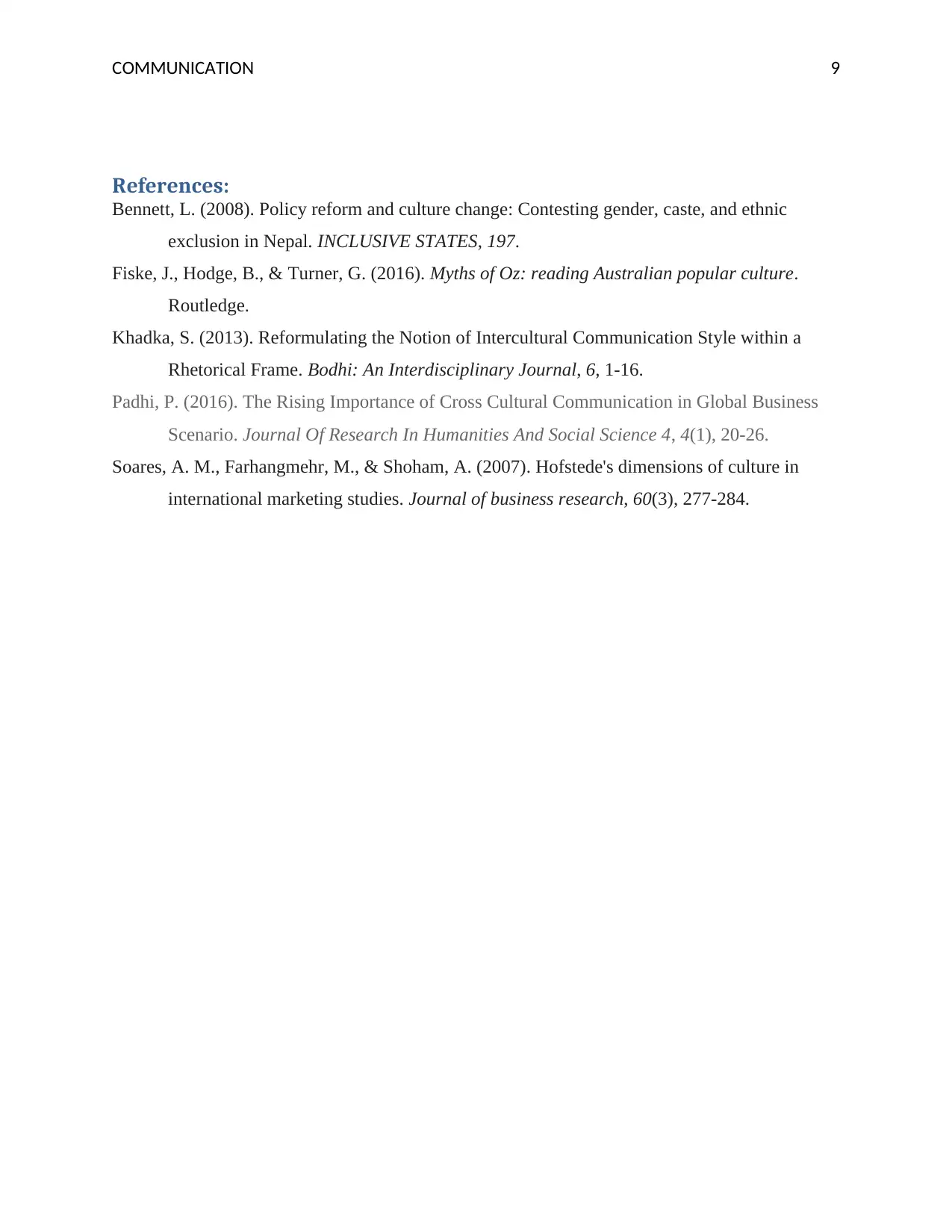
COMMUNICATION 9
References:
Bennett, L. (2008). Policy reform and culture change: Contesting gender, caste, and ethnic
exclusion in Nepal. INCLUSIVE STATES, 197.
Fiske, J., Hodge, B., & Turner, G. (2016). Myths of Oz: reading Australian popular culture.
Routledge.
Khadka, S. (2013). Reformulating the Notion of Intercultural Communication Style within a
Rhetorical Frame. Bodhi: An Interdisciplinary Journal, 6, 1-16.
Padhi, P. (2016). The Rising Importance of Cross Cultural Communication in Global Business
Scenario. Journal Of Research In Humanities And Social Science 4, 4(1), 20-26.
Soares, A. M., Farhangmehr, M., & Shoham, A. (2007). Hofstede's dimensions of culture in
international marketing studies. Journal of business research, 60(3), 277-284.
References:
Bennett, L. (2008). Policy reform and culture change: Contesting gender, caste, and ethnic
exclusion in Nepal. INCLUSIVE STATES, 197.
Fiske, J., Hodge, B., & Turner, G. (2016). Myths of Oz: reading Australian popular culture.
Routledge.
Khadka, S. (2013). Reformulating the Notion of Intercultural Communication Style within a
Rhetorical Frame. Bodhi: An Interdisciplinary Journal, 6, 1-16.
Padhi, P. (2016). The Rising Importance of Cross Cultural Communication in Global Business
Scenario. Journal Of Research In Humanities And Social Science 4, 4(1), 20-26.
Soares, A. M., Farhangmehr, M., & Shoham, A. (2007). Hofstede's dimensions of culture in
international marketing studies. Journal of business research, 60(3), 277-284.
1 out of 10
Related Documents
Your All-in-One AI-Powered Toolkit for Academic Success.
+13062052269
info@desklib.com
Available 24*7 on WhatsApp / Email
![[object Object]](/_next/static/media/star-bottom.7253800d.svg)
Unlock your academic potential
Copyright © 2020–2025 A2Z Services. All Rights Reserved. Developed and managed by ZUCOL.





